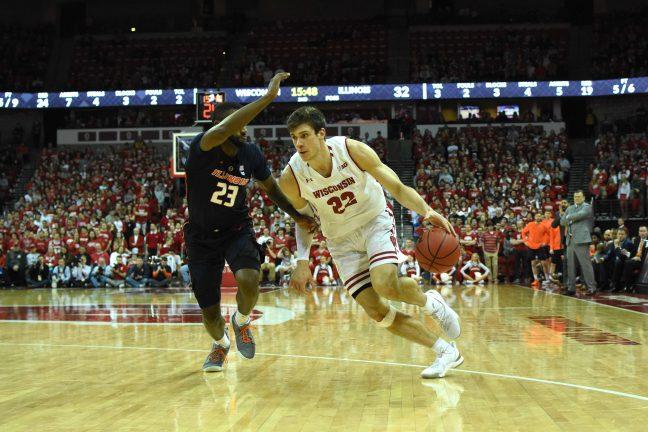One of the fundamentals of winning college basketball games is good free-throw shooting. As games come to an end, regardless of whether a team is leading or trailing, a team’s success at the free-throw line often can be the difference between a win and a loss, or between a national championship and an early NCAA Tournament exit.
Not one of the 10 most recent NCAA Champions shot below 70 percent from the stripe as a team, with six of those teams finishing top-20 in the nation in free throw percentage. When averaged out, the last ten teams to win the NCAA Tournament shot 75.4 percent from the free-throw line.
As of Feb. 22 — with five games remaining in the regular season — the University of Wisconsin men’s basketball team has shot 65 percent from the line, good for 328th out of 353 NCAA Division-I teams. While some of their losses can be attributed to factors other than a lack of success at the free throw line, the Badgers’ struggles have cost them a chance at winning meaningful games and have primarily stemmed from one player.
We all know how good Ethan Happ has been this season. As written previously, he is the only player ever in college basketball to average more than 18 points, 10 rebounds and five assists in a single season.
The only player ever.
But thanks to 11 straight misses from the line as of Feb. 22, his season free-throw percentage has dipped to a dreadful 43 percent. Happ is now also the only player in Division-I history to average more than 17.5 points in a season and shoot less than 45 percent from the stripe, and is one of two to average more than 17 points and convert free throws at less than a 45 percent rate (Chuck Stuart did so in the 1993-94 season at Florida International).
Happ has garnered serious national player of the year attention this season, and it is well deserved. But if he were to win the award with his current statistics, he would fall 12 percent under Bill Walton’s 1972-73 record for the lowest free throw percentage by an award winner. He would also be the only award recipient in the last nine years to shoot below 71 percent from the stripe.
And Happ’s free-throw deficiencies have already been a deciding factor in close games. Most recently, Happ struggled to make key free throws late in the second half against Michigan State, and while Wisconsin defeated both Minnesota and Maryland earlier this month, both games were decidedly closer after Happ could not make key free throws down the stretch to give Wisconsin a comfortable lead.
If all of Happ’s 113 free throw attempts this season were erased, 49 of them makes, the Badgers would rise from 328th in the nation to 63rd in free throw percentage and would rank higher than teams including Duke and Villanova.
In last Monday’s win against Illinois, Happ sat out the final four minutes of the game. The game was close and was clinched thanks to Wisconsin’s good free throw shooting down the stretch.
“It was tough because you want to be out there with your team and help them win,” Happ said. “I trust in my guys and coach did too and we ended up winning the game so that’s all there is to it.”
Happ’s playing time at the end of close games, or lack thereof, will be an interesting story to follow as the Badgers close in on the Big Ten and NCAA tournaments.
Nearly two decades ago, the ‘Hack-a-Shaq’ strategy — intentionally fouling poor free throw shooters late in games common — made its mark on the NBA, though it has not been as common in college basketball. But there may be situations going forward where Head Coach Greg Gard benches Happ at the end of games, like he did against Illinois, to avoid a potential ‘Hack-a-Happ’ movement from gaining steam.
Gard has strong free throw shooters on his roster, including Brevin Pritzl, Brad Davison, D’Mitrik Trice, Nate Reuvers and Kobe King — players who are all shooting at least 70 percent from the free-throw line in 2018-19. It would make sense for Gard to transition to a late-game lineup consisting of his best free-throw shooters if the situation calls for it come tournament time.
Despite his struggles at the line and sitting the end of Monday’s game, it’s still important to acknowledge that Happ’s performance is among the main reasons the Badgers are nationally ranked at this point in the season, and that his play will most likely dictate the Badgers’ success in March. After all, he was one of only eight Big Ten players named to the Naismith Award Watch List in early November, and has outplayed many of the other players on the list.
Happ and the Badgers will look to find their stride at the free-throw line and finish the regular season on the right note as they take on Big Ten foes Indiana, Penn State, Iowa and Ohio State in the coming weeks.


